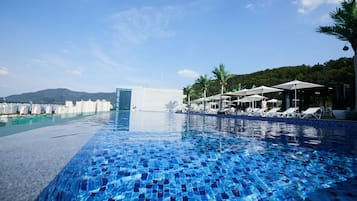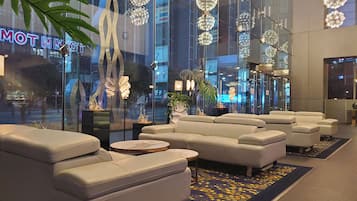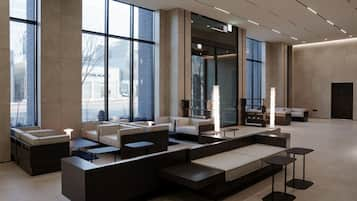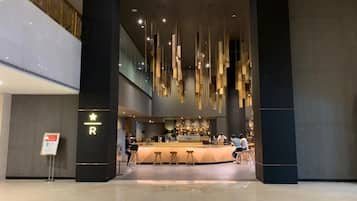The best things to do in Daegu embrace the city's rich and ancient culture. One of the largest cities in South Korea, it has a number of scenic attractions that boast views of the Palgongsan and the Apsan mountains, as well as historical sites dating back to the Silla periods and the Joseon Dynasty. The city’s beautiful parks offer exquisite scenery, especially during fall and spring.
You can also spend time exploring unique museums, which showcase a number of artefacts dating back to ancient times. Check out our guide of Daegu attractions below for some ideas on what to do and see during your holiday.
What are the best things to do in Daegu?
- 1
Duryu Park
Beautiful park with observation tower and temples

- Parejas
- Familias
Duryu Park is home to Daegu Tower, one of the tallest observatory towers in South Korea. The park is also popular for leisure and cultural attractions. A must-see is Osaek Fountain, which is said to contain mineral water with healing properties. You can also explore Duryu Library, Daeseongsa Temple and Geumyongsa Temple when you’re visiting the park.
Duryu Park is usually busiest during spring, when cherry blossoms are in full bloom. There are more than 133 species of trees and plants within the lush green landscape. The park’s facilities include a judo centre, a skating rink, swimming pool and a tennis court.
Ubicación: 36 Gongwonsunhwan-ro, Dalseo-gu, Daegu, South Korea
Teléfono: +82 (0)53-803-7470
MapaFoto de Chris Anderson (CC BY-SA 2.0) modificada
- 2
Bullo-dong Ancient Tomb Park
Extraordinary landscape in this ancient burial site

- Parejas
- Familias
One fascinating site in Gaedu is the Bullo-ding Ancient Tomb Park, where you’ll find an intriguing and distinctive sort of scenery. Bullo-dong Ancient Tomb Park is a mass burial site about 5 km north of Daegu city. It covers 330, 000 sq m, with around 200 grassy hillocks across the valley.
These hillocks are known as tumuli or burial mounds, and they date back to the 2nd and the 6th centuries. The mounds mark the tombs of nobles and commoners who lived during the period of Korea’s 3 States. You’ll also find artefacts from the tombs on display.
Ubicación: 335 Bullo-dong, Dong-gu, Daegu, South Korea
MapaFoto de riNux (CC BY-SA 2.0) modificada
- 3
Seonbosa Temple
A haven of peace above the city

- Económico
- Historia
Seonbosa Temple lies on the top of Palgongsan Mountain, about 20 km northeast of Daegu city. It’s a beautiful place to find peace and quiet close to the city. Many locals embark on a 3-hour-long hike up the hill to this 9th-century temple, especially during Buddhist celebrations and on the 1st day of every month.
One of Seonbosa Temple’s most visited landmarks is Gatbawi Buddha, which dates back to the 9th century. According to legend, this stone statue is believed to grant at least one of your wishes.
Ubicación: 35 Ganghak-gil, Gyeongsan-si, Gyeongsangbuk-do, South Korea
Teléfono: +82 (0)53-851-1868
Mapa - 4
Buinsa Temple
Elegant temple commemorating a queen

- Económico
- Historia
Daegu’s Buinsa Temple dates back to the 7th century and serves an affiliate temple of Donghwasa Temple. It’s also known as the memorial temple for Queen Seondeog of the Silla dynasty. A shrine for the queen was built within the premises, with memorial rituals taking place every 3rd lunar month.
One of the most popular attractions in Buinsa Temple is the west pagoda. It’s believed to have been constructed during the unified Silla era. Entrance is free year-round, but you’re welcomed to make a donation to the temple.
Ubicación: 967-28 Palgongsan-ro, Dong-gu, Daegu, South Korea
Teléfono: +82 (0)53-982-5006
Mapa - 5
Gyesan Catholic Cathedral
Red-brick Gothic church built in 1900

- Económico
- Historia
Gyesan Catholic Church, founded in 1900, is the city’s only remaining building from that period. This cathedral is a mix of Romanesque and Gothic styles, with stained glass windows and pinnacles.
It serves as Daegu’s main Catholic parish. There are several statues of the church’s founder in the rectory, and a memorial hall containing the remains of 65 Catholic martyrs. Daegu Gyesan Catholic Church is the 1st Gothic-style church in the Yeongnam region and the 3rd in the whole of Korea.
Ubicación: 10 Seoseong-ro, Jung-gu, Daegu, South Korea
Teléfono: +82 (0)53-254-2300
Mapa - 6
Donghwasa Temple
Ancient mountain-side shrine

- Económico
- Historia
Donghwasa Temple, which translates to the Temple of Winter Flowers, is an ancient shrine on the southern side of Palgongsan Mountain. It dates back to 493 AD, and was built by a monk named Guel-Dal during the 15th year of King Soji’s reign.
The Buddhist shrine was named after the flowers of Paulowania trees that grew within its compound. The prayer halls and pavilions are decorated with stone statues of mythic creatures and Buddhist deities. Check out the 17-metre-tall sculpture of Seokjoyaksa Yeoraebul, which was created as a petition to God for reunification.
Ubicación: 1 Donghwasa 1-gil, Dong-gu, Daegu, South Korea
Teléfono: +82 (0)53-471-1645
Mapa - 7
Daegu Spa Valley
Hot springs and pool complex

- Parejas
- Familias
Daegu Spa Valley is a place to relax and enjoy the experience of hot springs. The indoor complex has a health club and souvenir store on the 1st floor, while the 2nd floor features several hot spring pools, steam rooms, a herbal bath pool, a kiddie pool and a Korean bathhouse named a jjimjilbang.
There’s an outdoor water park, which consists of a youth pool, water polo pool, wave pool, waterslide and a diving pool. Daegu Spa Valley attracts those looking to experience a traditional Korean spa treatment. The sauna-like jjimjilbang is known for improving blood circulation and skin complexion.
Ubicación: 891 Gachang-ro, Gachang-myeon, Dalseong-gun, Daegu, South Korea
Horarios: Hours vary by season
Teléfono: +82 (0)1-688-8511
MapaFoto de Shawn Perez (CC BY 2.0) modificada
- 8
Daegu National Museum
Korean history dating back to the Neolithic

- Parejas
- Familias
- Historia
Daegu National Museum, one of the city’s largest museums, showcases the unique heritage of Daegu and the Buddhist culture of Gyeongsangbuk-do Province. The museum has about 30,000 artefacts dating back to the Neolithic era and the Korean dynasties, as well as Buddhist crafts, sculptures and statues.
Outside Daegu National Museum is a landscaped garden with several stone monuments that were excavated from several archaeological sites in Daegu. Must-sees include a 5-storey stone pagoda dating back to the Goryeo dynasty, a dwelling site from the Bronze Age and a restored kiln from the 3 Kingdoms period.
Ubicación: 321 Cheongho-ro, Suseong-gu, Daegu, South Korea
Horarios: Tuesday–Friday from 9 am to 6 pm, Saturday–Sunday from 9 am to 7 pm (closed on Mondays)
Teléfono: +82 (0)53-768-6051
MapaFoto de Trainholic (CC BY-SA 3.0) modificada
- 9
Pagyesa Temple
Temple dating back to 804 AD

- Económico
- Historia
Pagyesa Temple was founded in 804 AD by Simjiwangsa of the Silla kingdom. It lies on the western edge of Palgongsan Mountain, about 20 km northeast of Daegu city. Locals believe King Yeongjo of the Joseon Dynasty had a special fondness for Pagyesa Temple. According to Korean folktales, the king was born after a 100-day prayer by a Buddhist teacher of the temple.
Surrounded by lush trees, this serene temple serves Daegu’s Buddhist community. Before entering the main compound of Pagyesa Temple, you’ll first pass through Jindong-nu Hall, which hosts important Buddhist ceremonies year-round. Another must-visit is the bell pavilion, where you can see traditional percussion instruments on display.
Ubicación: 7 Jungdae-dong, Dong-gu, Daegu, South Korea
Teléfono: +82 (0)53-984-4550
MapaFoto de Ken Eckert (CC BY-SA 4.0) modificada
- 10
Palgonsan Natural Park
Scattered temples across the mountain

- Económico
- Parejas
- Familias
Palgonsan Natural Park has spectacular mountain scenery with magnificent granite formations, interwoven rock formations, thick forests and beautiful valleys. Located 20 km northeast of Daegu city, the lush park attracts hikers with scenic trails that lead to Buddhist shrines, such as Donghwasa Temple, Seonbosa Temple and Pagyesa Temple.
You can visit Palgonsan Natural Park just about any time of the year. See blooming azaleas in spring, enjoy autumn foliage along a 15-km pathway within the park and admire falling snow during wintertime.
Ubicación: 1034 Hanti-ro, Dongmyeong-myeon, Chilgok-gun, Gyeongsangbuk-do, South Korea
Teléfono: +82 (0)54-880-8300
MapaFoto de adam nicholson (CC BY 2.0) modificada
- 11
Yugasa Temple
Meditation in scenic surroundings

- Económico
- Historia
Yugasa Temple, located in the western valley of Mount Biseulsan, is one of the most secluded places in Daegu. The temple was founded by a Buddhist teacher named Doseongguksa in 827 AD. Thanks to its countryside location, it’s quite popular among those who like to meditate.
The rock cliffs and the peaks surrounding the temple further add to its scenic beauty. Stone stupas near the temple date back to the Joseon Dynasty. The Buddhist hermitages of Doseongam and Sudoam Hermitage are just behind the temple.
Ubicación: 144 Yang-ri, Yuga-myeon, Dalseong-gun, Daegu, South Korea
Teléfono: +82 (0)53-614-5115
Mapa - 12
Daegu Bangjja Brassware Museum
Authentic handforged metalware steeped in culture and history
- Parejas
- Familias
- Historia
The Daegu Bangjja Brassware Museum showcases hand-forged bronzeware named bangjja that was once used for presenting royal court cuisine in South Korea. Bangjja dates back to the Bronze Age, and used throughout the Goryeo and Chosun dynasties.
The museum has 2 levels dedicated to exhibits, cultural experiences and data research. The Brassware Cultural Hall is where you can learn about South Korea’s brassware history via informative exhibits of authentic bangjja. The displays at the Reappearance Hall in the museum illustrate where brassware was first produced and traded.
Ubicación: 29, Dojang-gil, Dong-gu, Daegu, South Korea
Horarios: April–October: Tuesday–Sunday from 10 am to 7 pm. November–March: Tuesday–Sunday from 10 am to 6 pm (closed on Mondays)
Teléfono: +82 (0)53-606-6171
Mapa - 13
Daegu Culture and Arts Center
Dynamic arts hub with a variety of performances and events
- Familias
- Historia
Daegu Culture and Arts Center showcases a variety of live performances year-round. It has an outdoor stage, an exhibition hall and 2 performance theatres. The main theatre hosts opera, concerts and dances, while the other is mainly used for plays and solo recitals. Expect to see world-class resident troupes, as well as special guest performers.
The outdoor stage can accommodate over 25,000 people, making it one of the largest in Korea. If you love art and music, the Daegu Culture and Arts Center is a must-visit. Make sure you book your tickets in advance.
Ubicación: 201 Gongwonsunhwan-ro, Dalseo-gu, Daegu, South Korea
Horarios: Hours vary by show and exhibition
Teléfono: +82 (0)53-606-6114
Mapa - 14
Biseulsan Recreational Forest
Family-friendly outdoor activities all year
- Económico
- Parejas
- Familias
Biseulsan Recreational Forest has a number of notable rock formations, pure streams and beautiful cliff walls. Located between 2 mountain peaks in Dalseong-gun, this family-friendly spot has a water playground for children, camping grounds and forest cabins for rent.
Spring is one of the best times to see beautiful pink azaleas in full bloom, but there’s something to do here year-round. During winter, Biseulsan Recreational Forest transforms into an outdoor theme park, with icicle hills, snow sleds, ice gardens and caves.
Ubicación: 230, Hyuyangnim-gil, Yuga-myeon, Dalseong-gun, Daegu, South Korea
Teléfono: +82 (0)53-659-4400
Mapa

















